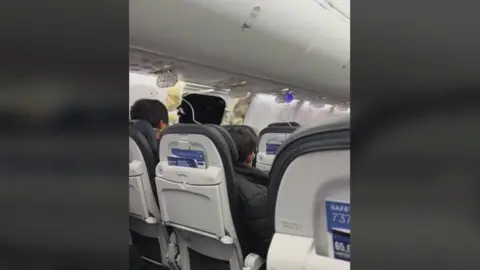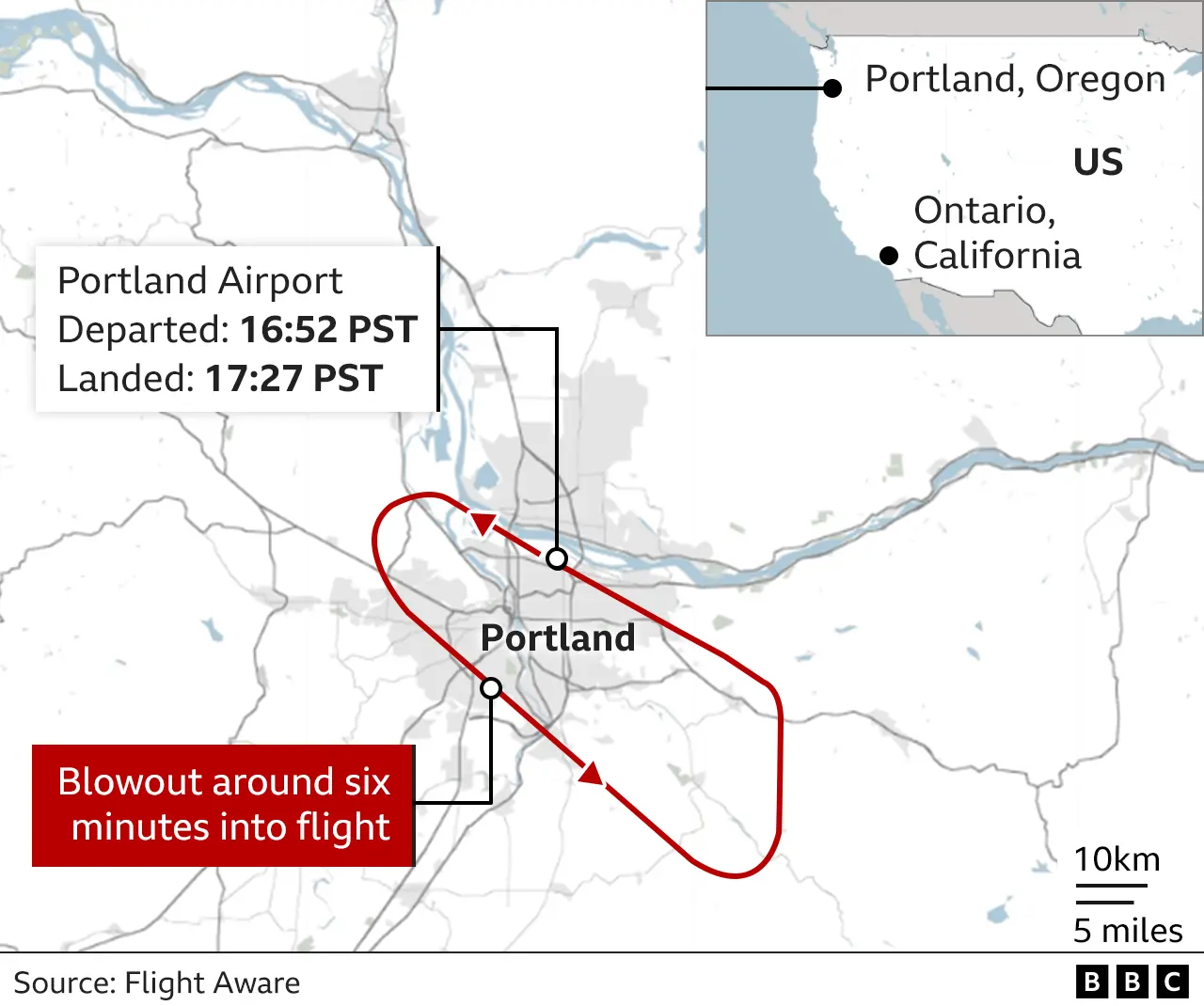Alaska Airlines grounds 737 Max 9 planes after section blows out mid-air
Alaska Airlines says it has returned some of its grounded Boeing 737 Max 9 jets to service after one of its planes lost a section of fuselage mid-flight.
The airline apologised to those affected, saying an inspection found "no concerning findings".
On Friday one of its planes had to make an emergency landing in the US state of Oregon after an outer section of the plane fell off.
The plane, carrying 177 passengers and crew, landed safely in Portland.
Boeing said it was aware of the incident and was "working to gather more information".
The UK Civil Aviation Authority told the BBC it was "monitoring the situation very closely".
Evan Smith, one of the 171 passengers on board, said: "There was a really loud bang towards the left rear of the plane and a woosh noise - and all the air masks dropped.
"They said there was a kid in that row who had his shirt sucked off him and out of the plane and his mother was holding onto him to make sure he didn't go with it."
Diego Murillo said the gap was "as wide as a refrigerator".
Fellow passenger Elizabeth Lee added: "Part of the plane was missing and the wind was just extremely loud. but everyone was in their seats and had their belt on."
Jessica Montoia described the flight as a "trip from hell" adding a phone was taken out of a man's hand by the wind.
Announcing the initial grounding of 65 planes, Alaska Airlines' CEO Ben Minicucci said: "Each aircraft will be returned to service only after completion of full maintenance and safety inspections."
A later statement said that more than a quarter of those plans had been inspected and would return to service as there were no issues found.
The flight to Ontario, California, had reached 16,000ft (4,876m) when it began its emergency descent, according to flight tracking data.
Images sent to news outlets show the night sky visible through the gap in the fuselage, with insulation material and other debris also seen.
 Elizabeth/CBS News
Elizabeth/CBS NewsOther pictures show the seat closest to the affected section, a window seat that passengers said was unoccupied, leaning forward without its cushion.
"My heart goes out to those who were on this flight - I am so sorry for what you experienced," Mr Minicucci said. "I am so grateful for the response of our pilots and flight attendants."
'We're an emergency'
In an audio clip, the pilot can be heard talking to air traffic control requesting a diversion.
"We are an emergency," she said. "We are depressurised, we do need to return back."
According to photographs, the affected area was in the back third of the plane, behind the wing and engines.

The section of fuselage involved appears to be an area that can be used as an additional emergency exit door by some operators, but not by Alaska.
The US Federal Aviation Administration (FAA) confirmed Alaska Airlines Flight 1282 "returned safely... after the crew reported a pressurisation issue".
Boeing said a "technical team stands ready to support the investigation".
Flydubai told the BBC that its three Boeing 737 Max 9 had a "different configuration with mid-aft cabin exits" compared to the Alaska Airline planes and have completed recent safety checks.
"We will follow any guidance issued by Boeing once more information is available," a spokeswoman added.
 Reuters
ReutersThe National Transportation Safety Board (NTSB) is investigating the incident.
The Boeing 737 Max has been described as "the most scrutinised transport aircraft in history" after a series of safety issues.
The Max was grounded in March 2019 for a year-and-a-half after two of the type crashed in similar circumstances to each other killing those on board.
Aviation expert John Strickland said the Alaska Airlines incident was very different to those crashes, adding that since the 737 Max came back into service it had a "very good safety record".
"While we know little evidence of why this section of the fuselage has come out - this has nothing to do with the aircraft being grounded for 18 months," he told BBC News.
"But, it is natural Alaska Airlines is taking a cautious approach grounding its fleet"
More recently, Boeing said it would increase the pace of 737 Max deliveries after resolving a supply error that required it to conduct lengthy inspections of new planes and its inventory, Reuters news agency reported.
About 1,300 737 Max aircraft have been delivered to customers, Boeing data shows.
Last month, the FAA urged airlines to inspect Max models for a possible loose bolt in rudder control systems.

Were you on this flight? You can share your experiences by emailing [email protected].
Please include a contact number if you are willing to speak to a BBC journalist. You can also get in touch in the following ways:
- WhatsApp: +44 7756 165803
- Tweet: @BBC_HaveYourSay
- Upload pictures or video
- Please read our terms & conditions and privacy policy
If you are reading this page and can't see the form you will need to visit the mobile version of the BBC website to submit your question or comment or you can email us at [email protected]. Please include your name, age and location with any submission.
